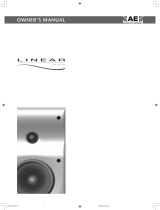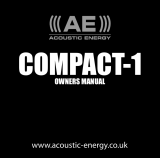Page is loading ...

OWNER’S MANUAL
AE1 Classic Rev C 13/12/05, 14:101

Welcome to the AE1 Classic monitor. Perhaps more than any other
professional audio product, monitors are sensitive to installation so please
take a little time to read this manual and to follow, as far as practical, the
installation guidelines it contains. Careful installation will help ensure that
your monitors perform optimally.
Following this introduction, the Manual is divided into sections covering
installation, positioning, connection, listening, specifications, and warranty
information. We recommend that you read at least the first four of these
sections carefully before installing and using your AE1 Classics.
The AE1 Classic is a relatively delicate precision engineered product that can
be damaged by inappropriate handling. Please take care when unpacking or
moving the monitors not to touch either of the drivers. Damage to a driver
will at best degrade performance and at worst result in complete failure.
The packaging should be retained for future use.
AE1 Classics are intended to be used mounted either on a mixing-desk
meter-bridge or preferably on speaker floor-stands relatively clear of room
boundaries. Alternative, near-wall, mounting arrangements such as wall
brackets are possible although these may result in less accurate performance.
If brackets are to be used they should be as rigid as possible and firmly
attached to brick-built walls.
The construction style, rigidity and dimensions of the floor-stands are of
critical significance to the performance of the AE1 Classic. Stands should
broadly follow the specification below. Your retailer or distributor will be able
to offer advice.
Recommended Floor-stand Specification.
Construction Style: Direct coupled pillared.
Mass Loading: Preferred.
Overall height: As appropriate for AE1 Classic top panel to be
just below head height when seated.
Top plate Dimensions
Minimum width: 160 mm
Maximum width: 180 mm
Minimum depth: 220 mm
Maximum depth: 240 mm
Top plate interface: Direct coupled tri-point or damped-compliance.
Floor interface: Floor spikes (M6 minimum).
1. Introduction
The position of monitors within the studio
room is likely to have more influence over their
performance than any other aspect of their
installation. It is worth spending some time
experimenting both with the finer points of
monitor positioning, as well as the larger scale
issues of room layout.
If you are already familiar with the acoustic
characteristics of your studio room, and the way
speakers perform in it, you may already have a
good feel for where to position your AE1 Classics.
However, installing any new component provides
a good opportunity to review an existing set-up
and perhaps make improvements.
The position requirements for a pair of AE1 Classics
installed in a typically sized and equipped studio
room, illustrated in Diagram One, are as follows:
• Stood upright, tweeters uppermost.
• Between 0.5 and 1.5 metres from the rear wall.
• 1.0 minimum metres from side walls.
• Between 2.0 and 3.0 metres apart.
• Clear of corners.
• Angled inward towards the primary monitoring
position.
Don’t worry if, thanks to the architecture or layout
of your room, it is not practical to follow each
requirement exactly. The most important thing is
to experiment with the different options that are
practical and find the one that works best.
Wherever your AE1 Classics are positioned it
is important that each of the pair is located
in a similar acoustic environment (different
environments would be, say, a curtained area and
a solid wall). The acoustic character of the side
walls of the room in the area where the main
reflection between speakers and listening position
will occur should also be similar.
2. Installation
3. Positioning
AE1 Classic Rev C 13/12/05, 14:102

1. Introduction
Once your AE1 Classics are connected and
working, and you begin to become familiar with
their performance, it is likely to be worthwhile
experimenting a little more with their positioning.
Reducing the distance between the monitors and
the rear wall will increase the level of bass and low
midrange making the monitors sound warmer.
The warmth however is likely to be gained at the
expense of some mid-range clarity and stereo
image focus and depth. Increasing the toe-in angle
of the monitors may regain some image focus but
again this is likely to be at a cost of image width
and openness. Learning through experimentation
how AE1 Classics behave in your studio will help
you find the optimum solution.
The AE1 Classic is not magnetically shielded and
should be kept away from magnetically sensitive
equipment or media.
Diagram One
2.5 metres
angle
inward
Listening position
0.5 metres from
back wall
Reflection
region. Keep
similar each
side.
4. Connecting
Connecting your AE1 Classics to an amplifier is fundamentally a simple
process. However, there are some choices to be made and issues to consider
concerning cable type.
Each AE1 Classic is fitted with a pair of binding-post terminals. The terminals
can accept stripped wires, spade connectors, or 4mm plugs. Each of these
termination methods is potentially equally effective and the choice is likely to
be influenced by type of speaker cable used.
Cable Type
Choice of cable type will be influenced by the characteristics of other
components in your monitoring system and your dealer or distributor will be
able to advise. Even so, there are some simple guidelines to consider:
• Cable runs to each speaker should be kept as short as possible
consistent with each being of equal length.
• Short cable runs are especially important if the cable is of relatively small
cross-sectional-area.
• If the cable is advertised as “directional” care should be taken to ensure
that its orientation is as recommended.
Connection Polarity
It is important when connecting speakers to ensure that each terminal is
connected with the correct polarity. Positive speaker terminals should always
be connected back to amplifier positive terminals, and negative speaker
terminals connected back to amplifier negative terminals. Performance will be
seriously degraded if connections are made with incorrect polarity.
Take care when connecting cables not to touch the negative and positive
terminals together and “short-circuit” the amplifier. Make connections with
the amplifier switched off.
AE1 Classic Rev C 13/12/05, 14:111

6. Amplifiers
Before using your AE1 Classics for the first time make one final check of the
cables and connections. If all appears well begin listening at a relatively low
level to confirm that the system is operating as expected. Only increase the
volume if you are happy with the sound at low levels. If you are unhappy,
turn the system off and re-check all the cables and connections.
AE1 Classics may take a little time to reach normal operating temperatures
and to “run-in”. It is unwise therefore to make too rapid a judgement about
the performance of the monitors. Your ears too will take some time to adjust
to the new sound so revisiting the speaker positioning is best left for a few
days.
7. Listening
The AE1 Classic is a medium sensitivity speaker that demands a relatively
powerful amplifier if adequate monitoring volume levels are to be achieved in
an average studio room. A minimum of 75 and maximum of 200 Watts into
8 Ohms per channel is recommended. AE1 Classics offer a relatively easy load
to the amplifier and do not make unusually heavy demands on its current
delivery.
No overload protection systems are fitted to the AE1 Classic so it is possible
to cause damage through over-driving. Such damage can occur whatever the
power rating of the driving amplifier and is not covered by any warranty. If
ever the sound at high volumes becomes distorted your AE1 Classics are at
risk of damage. In such circumstances the volume must be reduced.
8. Specification
Bass/Mid Driver: 90mm ceramic sandwich aluminium cone. 32mm edge-
wound voice-coil.
Tweeter: 25mm magnesium alloy dome.
Crossover: Symmetrical third order at 3kHz.
Power Handling: Compatible with amplifiers rated at up to 200 Watts into 8
Ohms
Frequency Response: 70Hz - 22kHz ±3dB
Sensitivity: 88dB for 2.83V at 1m
Nominal Impedance: 8 Ohms
Total Harmonic Distortion: Typically less than 0.3%, 200Hz to 20kHz
Power Compression: Less than 1dB for 16dB gain at 250Hz
Dimensions (H x W x D): 295 x 180 x 255mm
Weight (single speaker): 8kg
Your Acoustic Energy speakers are guaranteed
against original defects in materials, manufacture
and workmanship for 3 years from the date of
purchase.
Under this warranty Acoustic Energy agrees to
repair any defect or, at the company’s discretion,
replace the faulty component(s) without charge
for parts or labour. This warranty does not imply
any acceptance by Acoustic Energy or its agents
for consequential loss or damage and specifically
excludes fair wear and tear, accident, misuse or
unauthorised modification.
This warranty is applicable in the United Kingdom
only and does not in any way limit the customer’s
legal rights. Claims and enquiries under the
warranty for Acoustic Energy products purchased
outside the UK should be addressed to the local
importers or distributors. If you have reason to
claim under the warranty please contact your
dealer in the first instance.
Please retain all original packaging materials for
possible future use.
For any sales, technical or spares enquiries contact
your local dealer or distributor first.
9. Warranty
Acoustic Energy Limited, 16 Bridge Road, Cirencester, Gloucestershire GL7 1NJ.
Tel: +44 (0)1285 654432 (Sales), +44 (0)1285 656890 (Technical). Fax: +44 (0)1285 654430
Email: info@acoustic-energy.co.uk Web: www.acoustic-energy.co.uk
Manual Part No. MA1001
AE1 Classic Rev C 13/12/05, 14:112
/










